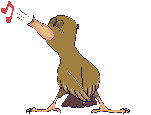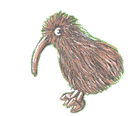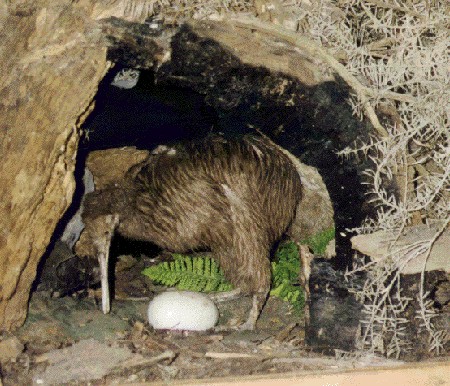|
|
Canku Ota |
|
|
(Many Paths) |
||
|
An Online Newsletter Celebrating Native America |
||
|
March 6, 2004 - Issue 108 |
||
|
|
||
|
How the Kiwi Lost His Wings |
||
|
Maori Legend |
||
|
credits: maori.org.nz |
|
He talked to his brother, Tanehokahoka, who called all of his children, the birds of the air together. Tanemahuta spoke to them. "Something is eating my children, the trees. I need one of you to come down from the forest roof and live on the floor, so that my children can be saved, and your home can be saved. Who will come?" All was quiet, and not a bird spoke.
"E Tui, will you come down from the forest roof?" Tui looked up at the trees and saw the sun filtering through the leaves. Tui looked down at the forest floor and saw the cold, dark earth and shuddered. "Kao, Tanehokahoka, for it is too dark and I am afraid of the dark." All was quiet, and not a bird spoke.
"Pukeko, will you come down from the forest roof?" Pukeko looked up at the trees and saw the sun filtering through the leaves. Pukeko looked down at the forest floor and saw the cold, damp earth and shuddered. "Kao, Tanehokahoka, for it is too damp and I do not want to get my feet wet." All was quiet, and not a bird spoke.
"Pipiwharauroa, will you come down from the forest roof?" Pipiwharauroa looked up at the trees and saw the sun filtering through the leaves. Pipiwharauroa looked around and saw his family. "Kao, Tanehokahoka, for I am busy at the moment building my nest." All was quiet, and not a bird spoke. And great was the sadness in the heart of Tanehokahoka, for he knew, that if one of his children did not come down from the forest roof, not only would his brother loose his children, but the birds would have no home.
"E kiwi, will you come down from the forest roof?" Kiwi looked up at the trees and saw the sun filtering through the leaves. Kiwi looked around and saw his family. Kiwi looked at the cold damp earth. Looking around once more, he turned to Tanehokahoka and said, "I will." Great was the joy in the hearts of Tanehokahoka and Tanemahuta, for this little bird was giving them hope. But Tanemahuta felt that he should warn kiwi of what would happen. "E kiwi, do you realise that if you do this, you will have to grow thick, strong legs so that you can rip apart the logs on the ground and you will loose your beautiful coloured feathers and wings so that you will never be able to return to the forest roof. You will never see the light on day again." All was quiet, and not a bird spoke. "E kiwi, will you come down from the forest roof?"
"I will." Then Tanehokahoka turned to the other birds and said, "E
Tui, because you were too scared to come down from the forest roof,
from now on you will wear the two white feathers at your throat
as the mark of a coward. Pukeko,
because you did not want to get your feet wet, you will live forever
in the swamp. Pipiwharauroa,
because you were too busy building your nest, from now on you will
never build another nest again, but lay your eggs in other birds
nests. But you kiwi, because of your great sacrifice, you will become the most well known and most loved bird of them all." Print and Color Your Own Kiwi |
|
|

 One
day, Tanemahuta was walking through the forest. He looked up at
his children reaching for the sky and he noticed that they were
starting to sicken, as bugs were eating them.
One
day, Tanemahuta was walking through the forest. He looked up at
his children reaching for the sky and he noticed that they were
starting to sicken, as bugs were eating them.  Tanehokahoka
turned to Tui.
Tanehokahoka
turned to Tui.  Tanehokahoka
turned to Pukeko.
Tanehokahoka
turned to Pukeko.  Tanehokahoka
turned to Pipiwharauroa.
Tanehokahoka
turned to Pipiwharauroa.  Tanehokahoka
turned to Kiwi.
Tanehokahoka
turned to Kiwi.  Kiwi
took one last look at the sun filtering through the trees and said
a silent goodbye. Kiwi took one last look at the other birds, their
wings and their coloured feathers and said a silent goodbye. Looking
around once more, he turned to Tanehokahoka and said,
Kiwi
took one last look at the sun filtering through the trees and said
a silent goodbye. Kiwi took one last look at the other birds, their
wings and their coloured feathers and said a silent goodbye. Looking
around once more, he turned to Tanehokahoka and said,  The
kiwi bird's name comes from the Maori language, and imitates the cry of
the male kiwi during the mating season. The first European settlers to
encounter the kiwi very sensibly used the Maori name, which is probably
thousands of years old, rather than trying to rename the bird.
The
kiwi bird's name comes from the Maori language, and imitates the cry of
the male kiwi during the mating season. The first European settlers to
encounter the kiwi very sensibly used the Maori name, which is probably
thousands of years old, rather than trying to rename the bird.  The
main breeding period is from late winter to summer. Nests may be in hollow
logs, under tree roots, in natural holes or in burrows excavated mainly
by the male. Most clutches contain one or two eggs. Eggs are smooth, and
coloured ivory or greenish-white. Kiwi eggs are proportionately larger
compared to the size of the adult female than the eggs of any other bird.
An egg may reach one-quarter of its mother’s weight. After the first
egg is laid, the male takes over incubation and nest maintenance. Incubation
takes about eleven weeks but if the female returns to lay another egg,
the male has to sit on the clutch for a much longer time. Leaving the
nest only occasionally, the male’s weight can decrease by up to one
third.
The
main breeding period is from late winter to summer. Nests may be in hollow
logs, under tree roots, in natural holes or in burrows excavated mainly
by the male. Most clutches contain one or two eggs. Eggs are smooth, and
coloured ivory or greenish-white. Kiwi eggs are proportionately larger
compared to the size of the adult female than the eggs of any other bird.
An egg may reach one-quarter of its mother’s weight. After the first
egg is laid, the male takes over incubation and nest maintenance. Incubation
takes about eleven weeks but if the female returns to lay another egg,
the male has to sit on the clutch for a much longer time. Leaving the
nest only occasionally, the male’s weight can decrease by up to one
third.